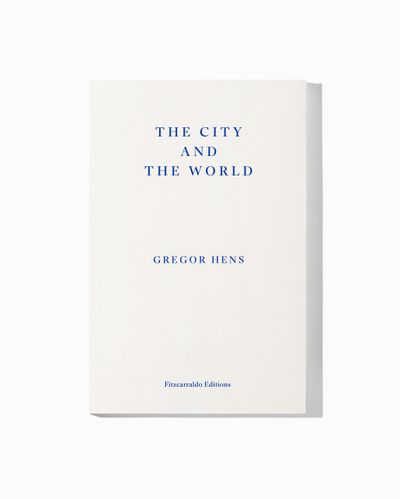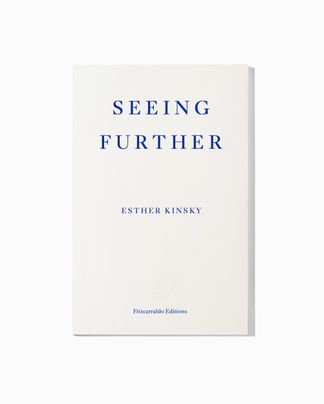In The City and the World, Gregor Hens explores the city in the twenty-first century – a space we shape and are shaped by in turn – and our place within it. Travelling from Berlin to Las Vegas, Shenzhen to Santiago de Chile, he moves through these pulsing, ever-expanding cityscapes, reading, walking, swimming, riding the metro and catching the bus, bearing witness to the strange vitality of urban life. Everywhere, catalysts for new understandings emerge. Pushing his young daughter’s pram turns Berlin upside-down. Students’ exercises in getting lost and reorienting themselves throw into question notions of centre and periphery. Google Maps becomes an unexpected gallery, offering new ways of encountering art and architecture. Buildings hold their own histories and secrets, illuminated by chroniclers of Hens’s cities, from Virginia Woolf and Georges Perec to Rem Koolhaas and Valeria Luiselli. Even libraries become cities in their own right. Blending memoir, travelogue and philosophy with photography and literary insights, The City and the World is a witty, captivating, illuminating and expansive journey into the heart of the modern city.

The City and the World
Translated by Jen Calleja
French paperback with flaps, 312 pages
Published 22 May 2025
The City and the World
Translated by Jen Calleja
0
From a garden in New Hampshire, I observed Jupiter’s moons. I could see Io creeping towards the gas giant’s surface, Europa emerging from its shadow to meet the retrograde Ganymede, the icy world of sparkling Callisto reaching deep into the blackness of space. All of this made it clear to me, clearer than ever, that the place in which we find ourselves is a mobile one, and I realized that we must determine our position every day anew. We calculate the orbits of the planets, read maps and coordinates, look for fixed stars and galaxies and use telescopes and sextants to cling to time measured in light years.
Perhaps we ought to close our eyes for a moment in order to feel the centrifugal and gravitational forces to which we are exposed as we turn our gaze inward and embark on a journey that is, by its very nature, fantastical. It might lead us across the vast sea and through the desert, to distant lands and to the highest peaks, but above all to the heaven-born cities of this world, which show us their wonders every day afresh.
I O
The Ibero-American Institute is located in the centre of Berlin, opposite Mies van der Rohe’s New National Gallery, and structurally connected to the adjacent Berlin State Library. The friendly atmosphere of its modest reading room is infectious. In the bright, straightforward space, tropical-looking plants grow in elegantly hidden clay boxes – a small, exquisite rainforest in the middle of the winter-grey city of Berlin.
Libraries are among the few places in our modern cities that are freely accessible to everyone, that are truly public and not in thrall to any commercial enterprise. Hip cafés are metastasizing even in public parks, and train stations can only be distinguished from shopping centres by the distant echo of the announcements rising from the catacombs of the underground platforms. Libraries, on the other hand, resist the increasing exploitation of public space; they are refuges, whose paddle-wheeling revolving doors have successfully kept out the sharp, icy draft of capitalism since the 1950s.
I’m writing these lines within sight of an English-language study on the impoverished strata of the population living on the outskirts of Santiago de Chile. It’s as if Santiago, a place I’ve never thought much about, has appeared before my eyes at its moment of crisis, when the masses of unemployed and underprivileged are streaming into the city centre to confront the armoured vehicles of the military on wide boulevards, joining up with the students protesting the increase in bus and metro fares. Churches and barricades are burning, shops are being looted, and the elite have holed up in Las Condes.
My Spanish has cooled, I can only read it with some effort, and yet I keep coming back to this library, where I can devote myself entirely to my work, surrounded by serious, quiet people. And if I hear the occasional whispered words, perhaps even a brief conversation, it doesn’t bother me in the slightest, because I don’t understand any more than I want to. The reading room with its dominant language is a Faraday cage against the noise of the world; the bookshelves are soundproofed walls, they swallow everything that has not been lodged in memory. Nothing from the outside gets in. I’m solitary, shielded, and yet not alone.
A library is like a city, it consists of streets and high-walled alleys, sometimes more, sometimes less busy squares, the library codes on the small metal flags that point into the narrow passageways are their discreet signage. Street lighting is installed on the upper shelves, and the wooden storage for the card catalogue serves as a traffic control centre.
In the early days of the digital age, the slips, some of which were still handwritten, were scanned, and the little cards, along with their crossings-outs, dog-ears and pencilled notes, appeared on the screens of the catalogue terminals. It was only later that these slips were actually processed into data readable by a computer. But the chests of drawers are still there, the light wood radiates southern warmth, and occasionally, only very rarely, this warmth draws me to them.
I get up to stretch my legs and open one of the long, narrow drawers in the thematic catalogue. My fingertips glide over the cards as if across harp strings and follow the references: Spanish Baroque Poetry… Francesco Petrarch… Papacy… Sin… Franz von Stuck. That was fast. I suspect that every book in this library, and indeed in every library in the world, is connected to all the other books through its themes, footnotes and subject headings, just as every street in a city is connected to all the others.
There is no place in Berlin, Santiago or New York from where you cannot get to every other point in the city and beyond – a fact that is only surprising when you consider how easy it is for a void to appear in a building, after a renovation for instance; a hidden space that cannot be escaped. History is full of unhinged builders; no doubt more than one has asked their architect to create a sealed room, a box without entry or exit – and why not? Maybe it’s supposed to provide shelter for Schrödinger’s cat, who is both dead and alive at the same time. And even if these speculations literally came to nothing, if there were no blank rooms anywhere else in the world, then one ought to be invented for the almost-mythical Palace of Justice in Brussels. Someone ought to scan this building, just as the Egyptian pyramids were X-rayed to find their secret chambers.
In fact, at least according to Jacques Austerlitz, the protagonist of W. G. Sebald’s novel, there are ‘corridors and stairways leading nowhere’ in the monstrous Brussels building, ‘doorless rooms and halls where no one would ever set foot.’ The walled void, says Austerlitz, is ‘the innermost secret of all sanctioned authority.’
Even fully occupied prisons, camps and psychiatric hospitals usually look as if they were empty from the outside; on Google Earth, not a soul can be seen in the notorious prisons of Alabama and the North Korean penal colonies. It’s as if the satellite had been lying in wait to catch that one moment when no food cart was being pushed across the yard, no delivery truck was getting ushered in, no three-pointer was being thrown on the basketball court at Holman Prison.
We don’t know whether the hidden room is truly empty, and we never will. At least it can be said with some certainty that the spectre of Belgium’s colonial crimes, the so-called Congo atrocities, which have not yet been completely dealt with, still resides in the Palace of Justice. In the pyramid chambers we suspect there are pharaohs’ daughters and mummified cats, both dead and alive at the same time. The names and existences of the millions of people interned all over the world were erased the moment they entered these camps; their lamentations only rarely penetrate the thick walls, so that the world may notice them.
If hidden rooms exist, we can also imagine books that are in no way networked to the knowledge gathered in this library – let alone the world’s knowledge. Books in which something is happening, in which at least one mummy is stirring. We just can’t find them. What would such a book be about? It would have to be concerned with itself and itself alone, without presupposing or connecting with the world in any way. It should posit the world with its very first words, just as Ludwig Wittgenstein’s Tractatus does: ‘The world is everything that is the case.’ But Wittgenstein failed, the way out of this book led up a ladder. In a letter to Louise Colet, Gustave Flaubert toyed with the idea of writing a book ‘dependent on nothing external, which would be held together by the strength of its style, just as the earth, suspended in the void, depends on nothing external for its support; a book which would have almost no subject…’ He never wrote this book, at least we don’t know if he did. The book is a hidden room.
(…)
‘Satisfyingly blends memoir with literary criticism, travelogue and social commentary to create an experimental text reminiscent of other Fitzcarraldo Editions favourites such as Brian Dillon’s Essayism.… [Hens’] tentacular style makes sense as a response to the overstimulating, frenetic character of modern cities. How we think and live is mapped on to the metropolis.’
— Sarah Moorhouse, The Spectator
‘Whether walking, swimming or reading, Hens is an inspiring guide and a patient teacher. I love the way he sees the world, as and in its cities.’
— Jon Day, author of Homing
‘Gregor Hens combines memories and reflections, reportage and theory to create an impressive book about the phenomenon of the city…. The appeal of the book, however, lies not in the diversity of the topics addressed, but in the seemingly effortless and almost somnambulistic way in which Hens combines his own memories and reflections, reportage and theory.’
— FAZ
‘This book is a blessing…. In a mixture of essay, autobiographical recollection and dream travelogue, the Cologne-born author takes us into all these exciting storehouses of stories and history in his richly illustrated book.’
— RND
‘This is the driving principle of his book: by virtue of his imagination, his sensibility and his readings, the author succeeds in spinning a web whose individual threads touch and extend into the distance.’
— Deutschlandradio Kultur
Gregor Hens is a German writer of fiction and creative nonfiction, and a literary translator. He received his PhD from the University of California at Berkeley and taught linguistics in the US for more than twenty years. He was a writer in residence at Magdalene College in Cambridge and has been shortlisted, with Rawi Hage, for the International Literature Prize (Berlin). He has notably translated Will Self and Kurt Vonnegut into German. Hens currently teaches Urban Studies and Creative Writing at the Free University in Berlin. His memoir Nicotine was published by Fitzcarraldo Editions in 2015.




